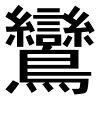Re: Preparation of Debian GNU/Linux 3.0r2 (II)
On Nov 24, 2003, at 11:15, GOTO Masanori wrote:
So it's hard to make Japanese characters which have beautiful shape
and unified baseline because each form is complex, and there are a lot
of such complicated characters.
Well, at the risk of starting a flame war, that says more about how
screwed up the language is than about the copyrightability (in the US)
of a work. The amount of work doesn't really matter; the amount of
creativity does. See, e.g., Feist v. Rural Telephone.
This is because we don't decide
easily that Japanese fonts are no creativity in even 32 dot bitmap
resolution. They are just art.
There is certainly some creativity in any font, otherwise all fonts
would look the same (or would be random). I'm sure neither is the case.
So it's hard to make Japanese characters which have beautiful shape
and unified baseline because each form is complex, and there are a lot
of such complicated characters. This is because we don't decide
easily that Japanese fonts are no creativity in even 32 dot bitmap
resolution. They are just art.
They are, as a matter of law in the United State, not copyrightable.
For example, this paragraph comes from the House Report on the 1976
Copyright Act:
A "typeface" can be defined as a set of letters, numbers or
other symbolic characters, whose forms are related by repeating
design elements consistently applied in a notational system and
are intended to be embodied in articles whose intrinsic
utilitarian function is for use in composing text or other
cognizable combinations or characters. The Committee does not
regard the design or typeface, as thus defined, to be a copyright
able "pictorial, graphic, or sculptural work" within the meaning
or this bill and the application of the dividing line in
section 101. [H.R. Rep. No. 1478, 94th Cong., 2d Sess. 55 (1976)].
In fact, before the 1976 act, typefaces were copyrightable in the
United States. Congress chose to change that.
See also 37 CFR Sec. 202.1, which reads (in part):
The following are examples of works not subject to copyright
and applications for registration of such works cannot be
entertained:
(e) Typeface as typeface.
There are other copyright office rulings saying that bitmap fonts can't
be copyrighted.
BTW: For the benefit of list readers who can't see that glyph, here it
is in PNG format w/ 96.0pt Osaka. Or, at least this is what my Mac
displays it as.

No, I have no idea what it means....
Reply to:
